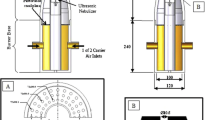Summary
A mathematical model for two-phase turbulent reactive flows is presented which is based on considering both phases in Lagrangian manner. The mechanical and thermodynamical properties of the two-phase mixture are calculated along the trajectories of “particles” representing the system. Similar to Monte-Carlo methods for solving a high dimensional joint velocity-composition probability density function, the turbulent gas phase is described by means of stochastic calculus. The deterministic equations for individual solid particles can be treated directly. In this approach, the interaction between both phases is not smeared over computational cells but restricted to the vicinity of solid particles by the definition of an “action-sphere” which is attached to every solid particle. Applications of the method to isotropic, homogeneous turbulence indicate that it is capable of providing information on the local structure of combustion zones with species formation and transport. The results show that the method is applicable independent of the combustion modes in the gas phase, and it provides extensive statistics of various correlations of properties.
Similar content being viewed by others
References
Berlemont, A., Grancher, M.-S., Gousebet, G.: On the Lagrangian simulation of turbulence influence on droplet evaporation. Int. J. Heat Mass Transfer11, 2805–2812 (1991).
Hansell, D., Kennedy, I. M., Kollmann, W.: A simulation of particle dispersion in a turbulent jet. Int. J. Multiphase Flow18, 559–576 (1992).
Yeh, F., Lei, U.: On the motion of small particles in a homogeneous isotropic turbulent flow. Phys. Fluids3, 2571–2586 (1991).
Riley, J. J., Patterson, G. S.: Diffusion experiments with numerically integrated isotropic turbulence. Phys. Fluids17, 292–307 (1974).
Squires, K. D., Eaton, J. K.: Preferential concentration of particles by turbulence. Phys. Fluids3, 1169–1178 (1991).
Mashayek, F., Taulbee, D. B., Givi, P.: Statistical modeling and direct simulation of two-phase turbulent flows. In: Advanced computation and analysis of combustion (Roy, G. D., Frolov, S. M. and Givi, P., eds.), pp. 161–174. Moscow. Russia 1997.
Elghobashi, S. E., Truesdell, G. C.: On the two-way interaction between homogeneous turbulence and dispersed solid particles. I: Turbulence modification. Phys. FluidsA5, 1790–1801 (1993).
Elghobashi, S. E., Truesdell, G. C.: On the two-way interaction between homogeneous turbulence and dispersed solid particles. II: Particle dispersion. Phys. Fluids6, 1405–1407 (1994).
Gousebet, G., Berlemont, A.: Eulerian and Lagrangian approaches for predicting the behaviour of discrete particles in turbulent flows. Prog. Energy Combust. Sci.25, 133–159 (1999).
Rose, M., Roth, P., Frolov, S. M., Neuhaus, M. G.: Lagrangian approach for modelling two-phase turbulent reactive flow. In: Advanced computation and analysis of combustion (Roy, G. D., Frolov, S. M. and Givi, P., eds.), pp. 175–194. Moscow, Russia 1997.
Nigmatulin, P. I.: Dynamics of multiphase media (in Russian). Moscow: Nauka 1987.
Reichelt, B., Roth, P., Wang, L.: Stoßwellen in Gas-partikel-Gemischen mit Massenaustausch zwischen den Phasen. Wärme- und Stoffübertragung19, 101–111 (1985).
Pope, S. B.: PDF methods for turbulent reactive flows. Prog. Energ. Combust. Sci.11, 119–151 (1985).
Xu, Ch. R., Fu, W. B.: Study on the burning rate of a carbon particle under forced convection conditions. Comb. Sci. Tech.124, 167–182 (1997).
Fuchs, N. A.: The mechanics of aerosols, pp. 30–34. Oxford: Pergamon Press 1964.
Uphoff, U., Hänel, D., Roth, P.: Influence of reactive particles on the structure of detonation waves. Comb. Sci. Techn.110–111, 419–441 (1995).
Hirschfelder, J. O., Curtics, C. F., Bird, B.: Molecular theory of gases and liquids. New York: Wiley 1954.
Libby, P. S., Williams, F. A. (eds.): Turbulent reactive flows, chap. 7: Recent developments on PDF methods, pp. 375–474. London: Academic Press 1994.
Dopazo, C.: Probability density function approach for a turbulent axisymmetric heated jet centerline evolution. Phys. Fluids18, 397–410 (1975).
Pope, S. B.: An improved turbulent mixing model. Comb. Sci. Techn.28, 131–135 (1982).
Valino, L., Dopazo, C.: A binomial Langevin model for turbulent mixing. Phys. Fluids3, 3034–3037 (1975).
Kraichnan, R.: Closures for probability distributions. Bull. Amer. Phys. Soc.34, 2298–2315 (1989).
Pope, S. B.: Mapping closures for turbulent mixing and reaction. Theor. Comput. Fluid Dynamics2, 255–270 (1991).
Frolov, S. M., Basevich, V. Ya., Neuhaus, M. G., Belyaev, A. A., Detkovskii, D. A., Noskov, M. A.: A coupled finite volume-joint velocity-scalar probability density function approach for modeling NOx formation in gas turbine combustors. In: 8th ONR Propulsion Meeting (Roy, G. D. and Williams, F. A., eds.). La Jolla, Ca., 1995.
Detkovskii, D. A., Frolov, S. M., Klemens, R., Tatschl, R., Mitgau, P., Wagner, H.-Gg.: Flame propagation in a free turbulent jet of premixed methane and dust-air mixtures. Archivum Combustionis16, 199–225 (1996).
Frolov, S. M., Basevich, V. Ya., Neuhaus, M. G., Tatschl, R.: A joint velocity-scalar PDF method for modeling premixed and nonpremixed combustion. In: Advanced computation and analysis of combustion (Roy, G. D., Frolov, S. M. and Givi, P., eds.). Moscow, Russia 1997.
Kee, R. J., Miller, J. A., Jefferson, T. H.: CHEMKIN: A general-purpose, problem-independent, transportable, FORTRAN chemical kinetics code package. Technical report, Sandia National Laboratories, SAND80-8003, 1980.
Author information
Authors and Affiliations
Rights and permissions
About this article
Cite this article
Rose, M., Roth, P. & Frolov, S.M. Modelling of a turbulent reacting gas/particle flow. Acta Mechanica 145, 45–63 (2000). https://doi.org/10.1007/BF01453644
Received:
Issue Date:
DOI: https://doi.org/10.1007/BF01453644




